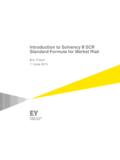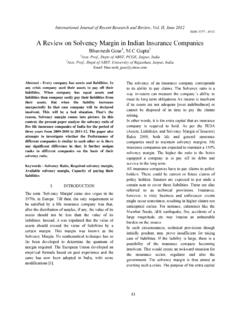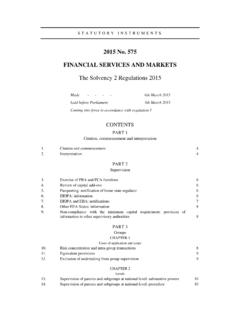Transcription of Impact assessment: Possible macroeconomic …
1 DG ECFIN/C-4(2007)REP 53199. Impact assessment : Possible macroeconomic and financial effects of solvency II. Contribution of DG ECFIN. March 2007. 1. Table of content 1 Introduction .. 3. 2 The Economic and Financial Importance of the EU insurance sector .. 5. The role of 5. Key economic and financial figures for the EU insurance sector .. 6. Key characteristics of the EU insurance sector .. 11. 3 Impact of solvency II on the EU insurance 17. Impact on capital requirements and excess capital .. 17. Balance sheet structure and the level of capital requirements .. 18. Volatility of capital 20. Valuation of assets and liabilities and portfolio reallocation.
2 20. Greater transparency and market discipline .. 22. Industry structure and business model .. 23. Organisational structure and processes .. 23. Insurance product design and prices .. 24. Overall Impact of solvency II on insurance sector .. 25. 4 Impact of solvency II on the EU economy and financial 26. Changes in insurance products supply .. 27. Availability of insurance products .. 27. Impact of insurance price changes .. 29. Impact of investment reallocation on financial markets .. 30. Impact on asset prices .. 30. Deepening of the euro area bond market .. 31. Impact on competition in the insurance 32.
3 Impact on risk 33. Transferring risks from insurers to other economic 33. Contagion 36. 5 38. Annex 1 .. 39. 2. 1 Introduction solvency II will introduce a new regulatory capital regime and modify the principles for the risk assessment in the management of assets and liabilities in the EU insurance sector. It should also streamline prudential practices and encourage supervisory convergence across Member States. The objective of solvency II is to improve the solvency of the insurance sector and, by extension, underpin the stability of the broader financial system, while offering policyholders a better guarantee that their contracts will be honoured.
4 In accordance with the Lamfalussy approach, the proposed framework Directive under solvency II (Level 1) will be complemented by implementing legislation (Level 2). As the implementing measures are unknown at this stage, the macroeconomic and financial impacts of solvency II are difficult to assess with precision. Accordingly, this Impact assessment (IA). for solvency II should be considered as largely qualitative and preliminary and there may be a need for revision as the implementation details emerge. The purpose of an IA is to identify the expected positive and negative effects of a proposal and to assess Possible trade-offs between these effects.
5 Prima facie evidence would suggest that macroeconomic Impact of solvency II would be marginal, while the impacts on financial sector particularly in terms of stability may be more significant. The approach followed in assessing the macroeconomic and financial Impact of solvency II is to review the various Possible transmission channels between the insurance sector and the economy and to infer, as far as Possible , from stylised facts the importance of these channels. Positive and negative transmission effects may offset, making assessment of the overall net effects rather tentative. When considering the Possible transmission channels of solvency II to the macro-economy and financial sector, two factors should be borne in mind.
6 First, the progressive transition from the existing national regulations to a new harmonized European regulation will imply both transition effects and longer-term steady-states effects. The transition effects - which are mainly short-term adjustment costs towards the new steady- state - may differ across Member States and across firm, reflecting different starting points. The long-term steady-state effects capture the structural implications of the new framework after full implementation. However, distinguishing between these two types of effects is not straightforward. For example, the new risk assessment methods implied by solvency II may lead to a transient increase in risk to financial stability during a learning period while the long-run effect would be stability enhancing.
7 As far as Possible , the analysis will distinguish between these two types of Second, the transmission of the effects of solvency II can be generally presented as: (1) the Impact on the insurance industry; (2) the transmission of the (financial) Impact from the industry to the macro-economy; and (3) the transmission of the (financial) Impact from the industry to stability of the financial system2. The Impact on the industry would include the implementation of the new computation methods for capital requirement, the Possible 1. It should be noted that following the first announcements relating to solvency II (2004), some insurance companies have anticipated the forthcoming Directive and have adjusted their risk management.
8 Therefore, to some extent, the transition period has already started. 2. See also Annex 1 for a schematic overview. 3. adjustment of business models etc. Subsequent impacts on the macro economy and financial sector would result from changes in assets-liability management techniques, changes in the demand for certain types of financial assets, reductions in insurance cover, changes on the budget constraint of firms and households etc. In terms of financial stability, changes in the supply of insurance products could result in a transfer of risks3 back to the households, firms or other financial intermediaries4.
9 The schematic representation above applies to the majority of transmission channels but not all. Moreover, it does not account for Possible feedback effects and endogeneity in the system. Possible interactions between different stages of the transmission mechanisms should also be borne in mind while reading the following sections. Moreover, the introduction of solvency II. should be seen in a broader context of rapidly changing and increasingly integrated financial markets, which would certainly influence the functioning of transmission channels from the insurance sector. The remainder of this note is structured as follows.
10 Section 2 assesses briefly the economic importance of the EU insurance sector in the economy, while describing the main features the sector. Section 3 explores the likely Impact of solvency II on the insurance sector. Section 4. builds on the previous section and considers the likely transmission of effects from the insurance sector to the macro-economy and financial system. (A summary diagram, illustrating of the macroeconomic and financial effects, is presented in Annex 1). Section 5. concludes and assesses the scope for further and more quantitative analysis. 3. Mainly investment risk. 4.















